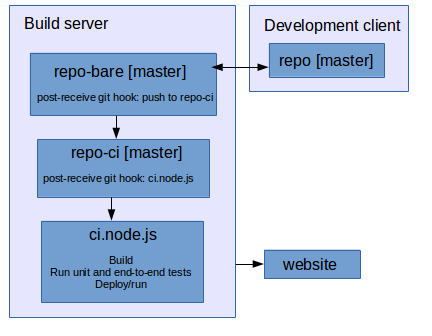Continuous Integration: Difference between revisions
No edit summary |
No edit summary |
||
| Line 1: | Line 1: | ||
Terminology: | Terminology: | ||
* build | * build can be: DEBUG, RELEASE | ||
* run mode | * app run mode can be: TEST, LIVE | ||
* dev env is | * dev env can be: | ||
** myrepo DEV where code is (mostly) written and tested | |||
** myrepo.git BARE where code is gathered and synced | |||
** myrepo-ci CI where app is automatically run and tested on any commit | |||
** myrepo-prod PROD where live app runs available to others | |||
Goals: | Goals: | ||
* on code save: automatically build | * on code save in DEV env: automatically build RELEASE, run TEST | ||
* on code commit: automatically build, do any custom build steps, run any unit tests, run any end-to-end tests, and report results dynamically | * on code commit: automatically build, do any custom build steps, run any unit tests, run any end-to-end tests, and report results dynamically | ||
* on app production release: compile artifacts, assist in automatic versioning | * on app production release: compile artifacts, assist in automatic versioning | ||
Revision as of 14:26, 22 November 2015
Terminology:
- build can be: DEBUG, RELEASE
- app run mode can be: TEST, LIVE
- dev env can be:
- myrepo DEV where code is (mostly) written and tested
- myrepo.git BARE where code is gathered and synced
- myrepo-ci CI where app is automatically run and tested on any commit
- myrepo-prod PROD where live app runs available to others
Goals:
- on code save in DEV env: automatically build RELEASE, run TEST
- on code commit: automatically build, do any custom build steps, run any unit tests, run any end-to-end tests, and report results dynamically
- on app production release: compile artifacts, assist in automatic versioning
Tools:
- git
- use a centralized bare repository as the origin target for all the client development environments; master will be the workhorse branch
- git hooks, especially post-receive on the server, which triggers when a new push arrives from any client; this is the entry point for CI server builds
- Node.js
- This allows us to write cross-platform CI scripts in a language that is fundamental to web development
- Base Node.js provides many important cross-platform functions; it is also fundamentally asynchronous
- Use modules and you get command-line support from any path on any platform's shell
- Windows
- window management via AutoHotKey; see various sync ahk scripts for examples
- Powershell; make sure to set it up to get debug output:
$global:DebugPreference = "Continue"
- Ubuntu i3
- Use i3 scripting to manage windows placement; see various keyboard shortcuts in config file for examples
That is all. And away we go!
